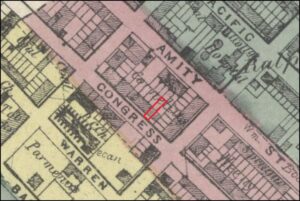Below is a small representation of the hundreds of investigations we’ve performed into our clients’ New York City properties. For each, we’ve produced a House History Book or House History Report. Contact us today to discover the history of YOUR house.
******************************************************************************************************************************** No. 125 Congress Street
No. 125 Congress Street – An approximately 162-year-old 3-story & basement brownstone row house situated in the Cobble Hill section of Brooklyn, New York, it sits 127’ from the corner of Henry Street with a frontage of 25’ and a depth of 100.’ It is one of two Italianate style brownstones – its sister-house being No. 127 — that were constructed at the same time in approximately the 1860s. “The easternmost pair of houses (Nos. 125-127),” notes the
Cobble Hill Historic District Designation Report, “the latest to be built, are alone on this blockfront in having brownstone facades. Unfortunately,” the report continues, “much of the detail has been shorn off of many of these houses.” The architectural details of No. 125’s façade, specifically, likely disappeared within the 1940s or 1950s when a trend to modernize brownstones was in

full swing. Before becoming a building parcel, No. 125’s lot had most recently belonged to the estate of fur merchant – and early work colleague of John Jacob Astor – Cornelius Heeney. Subsequent to 1845, when Heeney created the Brooklyn Benevolent Society, Heeney’s Brooklyn real property would be donated to that entity, to which it would belong for more than 100 years. The Brooklyn Benevolent Society would use its tax-exempt status to lease out its property to potential lessees (receiving 21-year leases, as dictated by the New York State Legislature) who would improve the land with houses which these lessees could live in, as well as rent out to others. Finally, after approximately 114 years of ownership of No. 125, the Brooklyn Benevolent Society conveyed the property (both land and brownstone) to its most recent lessee, who sold it immediately to a property rental company. Then, approximately 9 years afterwards, the property was sold to a contractor who “flipped” the property by carving it into condos, each of which were then sold to individual buyers.
 No. 125 Congress Street – An approximately 162-year-old 3-story & basement brownstone row house situated in the Cobble Hill section of Brooklyn, New York, it sits 127’ from the corner of Henry Street with a frontage of 25’ and a depth of 100.’ It is one of two Italianate style brownstones – its sister-house being No. 127 — that were constructed at the same time in approximately the 1860s. “The easternmost pair of houses (Nos. 125-127),” notes the Cobble Hill Historic District Designation Report, “the latest to be built, are alone on this blockfront in having brownstone facades. Unfortunately,” the report continues, “much of the detail has been shorn off of many of these houses.” The architectural details of No. 125’s façade, specifically, likely disappeared within the 1940s or 1950s when a trend to modernize brownstones was in
No. 125 Congress Street – An approximately 162-year-old 3-story & basement brownstone row house situated in the Cobble Hill section of Brooklyn, New York, it sits 127’ from the corner of Henry Street with a frontage of 25’ and a depth of 100.’ It is one of two Italianate style brownstones – its sister-house being No. 127 — that were constructed at the same time in approximately the 1860s. “The easternmost pair of houses (Nos. 125-127),” notes the Cobble Hill Historic District Designation Report, “the latest to be built, are alone on this blockfront in having brownstone facades. Unfortunately,” the report continues, “much of the detail has been shorn off of many of these houses.” The architectural details of No. 125’s façade, specifically, likely disappeared within the 1940s or 1950s when a trend to modernize brownstones was in  full swing. Before becoming a building parcel, No. 125’s lot had most recently belonged to the estate of fur merchant – and early work colleague of John Jacob Astor – Cornelius Heeney. Subsequent to 1845, when Heeney created the Brooklyn Benevolent Society, Heeney’s Brooklyn real property would be donated to that entity, to which it would belong for more than 100 years. The Brooklyn Benevolent Society would use its tax-exempt status to lease out its property to potential lessees (receiving 21-year leases, as dictated by the New York State Legislature) who would improve the land with houses which these lessees could live in, as well as rent out to others. Finally, after approximately 114 years of ownership of No. 125, the Brooklyn Benevolent Society conveyed the property (both land and brownstone) to its most recent lessee, who sold it immediately to a property rental company. Then, approximately 9 years afterwards, the property was sold to a contractor who “flipped” the property by carving it into condos, each of which were then sold to individual buyers.
full swing. Before becoming a building parcel, No. 125’s lot had most recently belonged to the estate of fur merchant – and early work colleague of John Jacob Astor – Cornelius Heeney. Subsequent to 1845, when Heeney created the Brooklyn Benevolent Society, Heeney’s Brooklyn real property would be donated to that entity, to which it would belong for more than 100 years. The Brooklyn Benevolent Society would use its tax-exempt status to lease out its property to potential lessees (receiving 21-year leases, as dictated by the New York State Legislature) who would improve the land with houses which these lessees could live in, as well as rent out to others. Finally, after approximately 114 years of ownership of No. 125, the Brooklyn Benevolent Society conveyed the property (both land and brownstone) to its most recent lessee, who sold it immediately to a property rental company. Then, approximately 9 years afterwards, the property was sold to a contractor who “flipped” the property by carving it into condos, each of which were then sold to individual buyers.